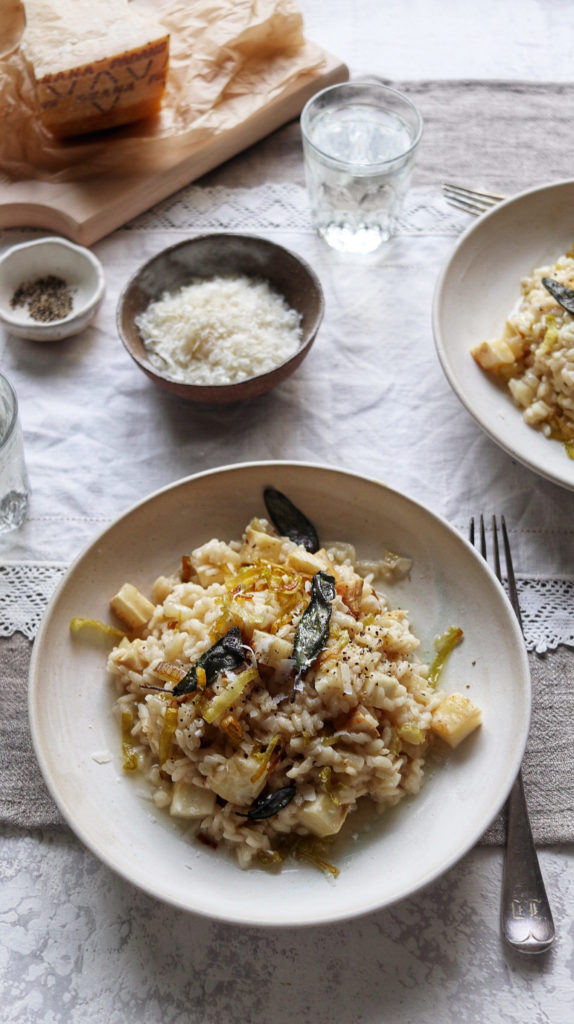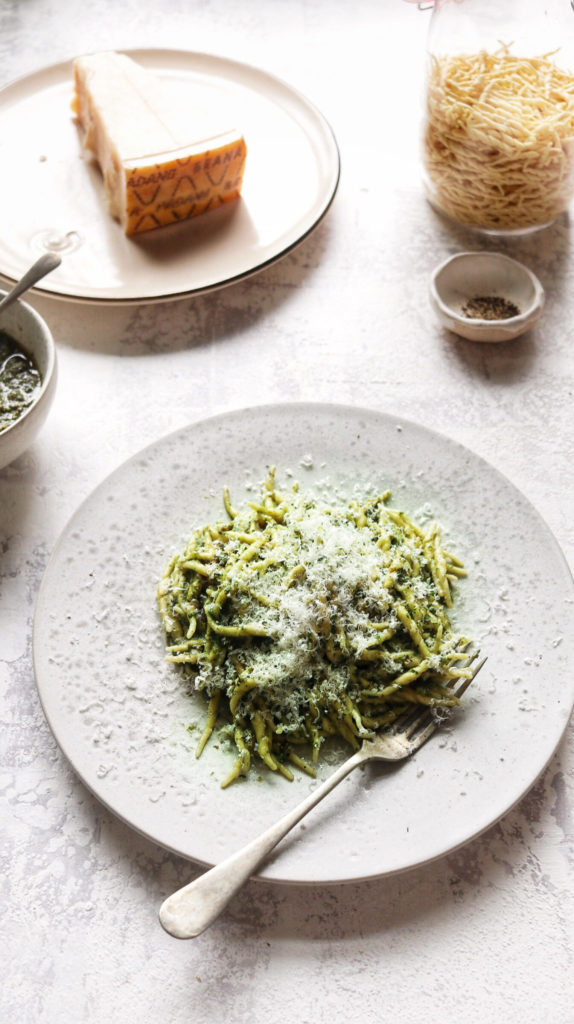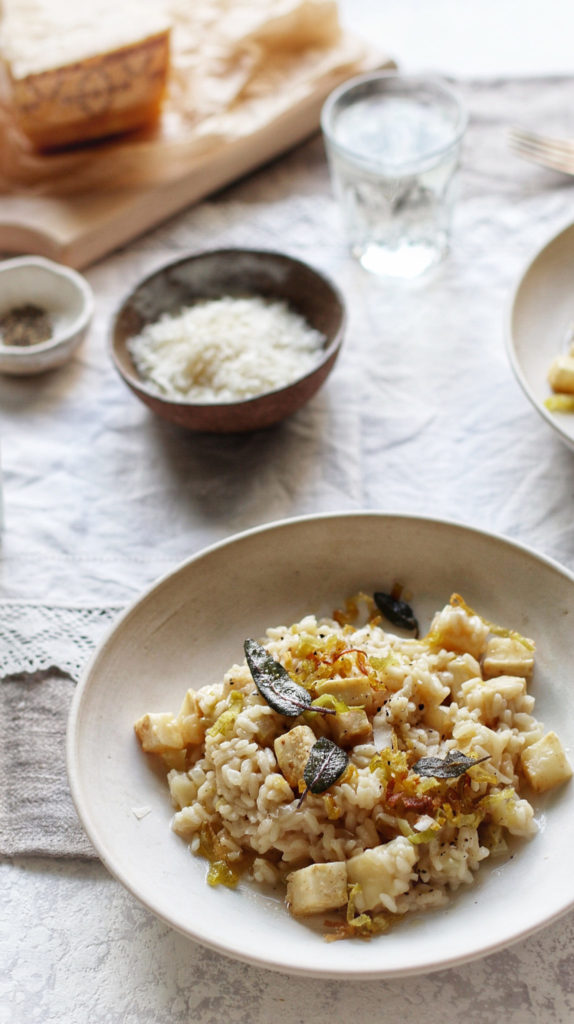
*This is a paid partnership with Grana Padano*
If you’re a regular reader you’ll be used – by now – to me banging on about how much I love celeriac. Aside from being one of the most versatile winter veg around, its sweet, nutty, creamy charms are the perfect match for cheese, and particularly a hard, complex cheese like Grana Padano.
This risotto is a zero waste risotto because it uses two very flavourful things that might otherwise go to waste – the celeriac peel and the cheese rind – to inject an extra layer of flavour into the dish. The peel and rind together create one of the most gorgeously fragrant stocks I’ve ever made, which is used to make the risotto, while the celeriac flesh is salt baked to concentrate the flavour and tenderise, and then basted in sage infused-brown butter before being stirred through the creamy rice with more freshly grated Grana Padano.
One of the most common complaints about risotto is that it’s too one-note in terms of texture, but not on my watch, pals. Crispy fried leeks are added for a bit of texture and sweetness – it’s a rich, layered dish that’s perfect for a chilly night in. I’m really in love with it and I hope you’re going to like it as much as me – the stock is a game changer: at once sweet and savoury – and is going to become a staple whenever I peel a celeriac, which, let’s face it, can be a hassle, so it’s good to be rewarded for the effort. Just be sure to wash the peel first – no one wants a gritty stock. If you’re worried though, you can always pass it through a coffee filter.
Also below is a recipe for trofie pasta and seasonal pesto. While it might look strikingly similar to the Ligurian classic: trofie al pesto Genovese it’s not. Trofie, a short, twisted pasta shape from Liguria is classically served with a pesto of fragrant Genovese basil pounded with pine nuts, olive oil, hard cheese and garlic, often served with green beans and potatoes too. The shape is particularly adept at picking up the flecks of tasty pesto, and it has a wonderful substantial bite, if cooked until al dente, which I adore. If you can’t find trofie then orrecchiette or tagliatelle would work well here too. In this dish, rather than basing the pesto around basil, I’ve used peppery watercress which is locally available and bang in season, along with a little basil for sweetness and fragrance. It’s blitzed together with sweet flaked almonds, lemon zest to lift, and crumbly, complex Grana Padano for a punchy green sauce.

If you make the quantities in the recipe below you might have too much, but there’s not any point in scaling back the recipe as you can enjoy any leftover pesto on poached eggs, in salad dressings, spooned onto roasted veg on in sandwiches.
*Some more info about Grana Padano*
Grana Padano is one of Italy’s most historic cheeses. It’s made with raw milk from the Northern Italian production area of the Po River Valley, which takes in the regions of Piedmont, Lombardy, Veneto, some areas of Trento and the province of Piacenza in Emilia Romagna. It achieved PDO (Protected Designation of Origin) in 1996, meaning that it can only be made within the accredited production area following strict traditional methods. As such, it’s an agricultural product – linked inextricably to the terroir, climate and culture of the people that produce it.
Its heritage goes back 1000 years, to when it was first created by ingenuitive Benedictine monks who rustled up the hard cheese as a way of preserving surplus milk – cooking it up in huge cauldrons in their monasteries, which are considered the first dairies. It was known to them as ‘caseus vetus’ in Latin – meaning ‘old cheese’, but soon became known as ‘Grana’ by the Italian people thanks to its grainy texture.
Each wheel of cheese is aged for a minimum of 9 months for a milkier, sweeter cheese, and up to 24 months for a deeper, more concentrated, grainier cheese.
Celeriac, sage and Grana Padano risotto with crispy leeks and Trofie with watercress and olive pesto and Grana Padano pesto
1 small celeriac (about 500g)
Sea salt
1 carrot, peeled and chopped
4 black peppercorns
Large piece of Grana Padano rind
1/4 leek, finely sliced (trim reserved and rinsed)
2 tsp rice flour
2 tbsp neutral oil (rapeseed or groundnut)
50g butter
Serves 4
6 sage leaves
1 medium onion, peeled and finely chopped
2 sticks celery, peeled and finely chopped
200g arborio risotto rice
150ml white vermouth
100g grated Grana Padano
For the trofie and watercress pesto
Serves 2 (with extra pesto)
80g watercress
15g basil leaves
60g flaked almonds
80g Grana Padano
1 clove garlic, crushed
2 tbsp water
Zest of ½ lemon
Tbsp lemon juice
80ml extra virgin olive oil
200g trofie pasta (orecchiette, tagliatelle and cavatelli also work well)
- Heat the oven to 180 fan and scatter a couple of handfuls of sea salt over the bottom of a large roasting tray in an even layer. Cut the gnarly root from your celeriac and then peel it (do not discard the root and peel as you’ll use it for stock), cut it in half, place it cut side down and then cut each half into inch thick wedges. Rinse the peel and root clean of any mud and place it in a pot with a bay leaf, cheese rind, carrot, peppercorns, leek trim and a good pinch of salt. Cover with 800ml cold water and bring to the boil. Skim off any scum, turn the heat down, add a good pinch of sea salt and simmer for at least 45 minutes – this will be your stock for the risotto. Place the celeriac wedges on the salt and roast for 30 minutes on the top shelf of the oven. Remove from the oven, allow to cool and then dust the salt from the wedges and cut into bitesized cubes. Throw any trim into the bubbling stock.
- Toss the leeks with the rice flour to coat, then, in a large frying pan, combine them with two tbsp neutral oil. Bring up over a gentle heat and cook for a few minutes, until the leeks are frizzling, crisping and turning golden. As soon as they start to turn, remove from the oil with a fork or slotted spoon and drain on kitchen paper. Season with a pinch of sea salt. Clean the pan to get rid of any residual rice flour, then melt a good knob of butter (about 2 tbsp) over a medium heat. Once melted and foaming, toss in the sage leaves and gently fry, stirring, until the butter is infused and the leaves have crisped, removing them to kitchen towel for garnish. The butter should be starting to brown now. Add the celeriac into the pan and toss to coat in the warm sage butter, basting the veg for a couple of minutes in the brown butter. Add a squeeze of lemon juice in to stop the butter getting too dark, stir and remove from the heat for later.
- Strain your stock and warm over a hob. Melt the remaining butter in a large pan. Fry the onion and celery gently for about 10 minutes over a medium heat, until softened but not coloured. Turn the heat up slightly, slide in the rice and toss with the buttered veg, cooking for a couple of minutes until it’s turning translucent. Pour over the vermouth and cook for a couple of minutes, until it’s mostly absorbed, then start to add in the warm stock, two ladlefuls at a time, simmering and stirring until it’s almost all absorbed, and repeating until all of the stock is absorbed and the rice is plumped and creamy, but still retaining its shape and a tiny bite (though not chalky).
- Stir through the ¾ celeriac and sage butter and ¾ the cheese, stirring until just melted. Season to taste. Divide between warm bowls and top with the crispy leeks and extra celeriac and sage butter. Serve with extra cheese on the side.
For the trofie and pesto
- Wash the watercress and basil, shake dry, then place in a food processor or mini chopper along with the almonds, lemon zest and juice, cheese, garlic and water and blitz to a green paste. Add the olive oil and blitz again until emulsified. Season to taste with salt and pepper.
- In a large pot of well-salted water, cook your pasta until al dente – (for trofie this will take 10 mins), then drain, reserving a cup of pasta water. Return the pasta to the pan with a tbsp pasta water and stir through 4 tbsp of the pesto over a gentle heat. Serve and shower with more Grana Padano.
